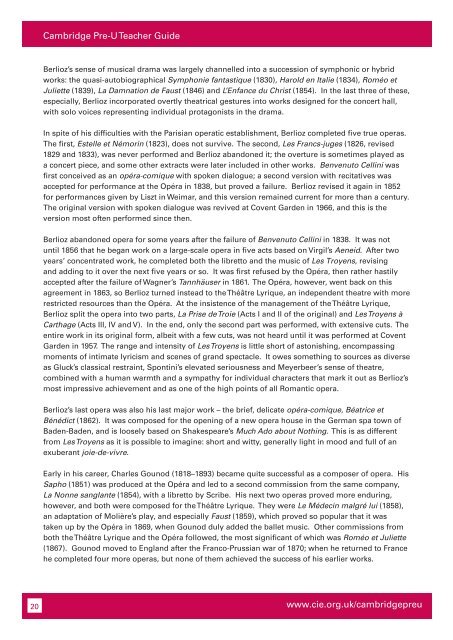Teacher's Guide Cambridge Pre-U MUSIC Available for teaching ...
Teacher's Guide Cambridge Pre-U MUSIC Available for teaching ...
Teacher's Guide Cambridge Pre-U MUSIC Available for teaching ...
You also want an ePaper? Increase the reach of your titles
YUMPU automatically turns print PDFs into web optimized ePapers that Google loves.
20<br />
<strong>Cambridge</strong> <strong>Pre</strong>-U Teacher <strong>Guide</strong><br />
Berlioz’s sense of musical drama was largely channelled into a succession of symphonic or hybrid<br />
works: the quasi-autobiographical Symphonie fantastique (1830), Harold en Italie (1834), Roméo et<br />
Juliette (1839), La Damnation de Faust (1846) and L’Enfance du Christ (1854). In the last three of these,<br />
especially, Berlioz incorporated overtly theatrical gestures into works designed <strong>for</strong> the concert hall,<br />
with solo voices representing individual protagonists in the drama.<br />
In spite of his difficulties with the Parisian operatic establishment, Berlioz completed five true operas.<br />
The first, Estelle et Némorin (1823), does not survive. The second, Les Francs-juges (1826, revised<br />
1829 and 1833), was never per<strong>for</strong>med and Berlioz abandoned it; the overture is sometimes played as<br />
a concert piece, and some other extracts were later included in other works. Benvenuto Cellini was<br />
first conceived as an opéra-comique with spoken dialogue; a second version with recitatives was<br />
accepted <strong>for</strong> per<strong>for</strong>mance at the Opéra in 1838, but proved a failure. Berlioz revised it again in 1852<br />
<strong>for</strong> per<strong>for</strong>mances given by Liszt in Weimar, and this version remained current <strong>for</strong> more than a century.<br />
The original version with spoken dialogue was revived at Covent Garden in 1966, and this is the<br />
version most often per<strong>for</strong>med since then.<br />
Berlioz abandoned opera <strong>for</strong> some years after the failure of Benvenuto Cellini in 1838. It was not<br />
until 1856 that he began work on a large-scale opera in five acts based on Virgil’s Aeneid. After two<br />
years’ concentrated work, he completed both the libretto and the music of Les Troyens, revising<br />
and adding to it over the next five years or so. It was first refused by the Opéra, then rather hastily<br />
accepted after the failure of Wagner’s Tannhäuser in 1861. The Opéra, however, went back on this<br />
agreement in 1863, so Berlioz turned instead to the Théâtre Lyrique, an independent theatre with more<br />
restricted resources than the Opéra. At the insistence of the management of the Théâtre Lyrique,<br />
Berlioz split the opera into two parts, La Prise de Troie (Acts I and II of the original) and Les Troyens à<br />
Carthage (Acts III, IV and V). In the end, only the second part was per<strong>for</strong>med, with extensive cuts. The<br />
entire work in its original <strong>for</strong>m, albeit with a few cuts, was not heard until it was per<strong>for</strong>med at Covent<br />
Garden in 1957. The range and intensity of Les Troyens is little short of astonishing, encompassing<br />
moments of intimate lyricism and scenes of grand spectacle. It owes something to sources as diverse<br />
as Gluck’s classical restraint, Spontini’s elevated seriousness and Meyerbeer’s sense of theatre,<br />
combined with a human warmth and a sympathy <strong>for</strong> individual characters that mark it out as Berlioz’s<br />
most impressive achievement and as one of the high points of all Romantic opera.<br />
Berlioz’s last opera was also his last major work – the brief, delicate opéra-comique, Béatrice et<br />
Bénédict (1862). It was composed <strong>for</strong> the opening of a new opera house in the German spa town of<br />
Baden-Baden, and is loosely based on Shakespeare’s Much Ado about Nothing. This is as different<br />
from Les Troyens as it is possible to imagine: short and witty, generally light in mood and full of an<br />
exuberant joie-de-vivre.<br />
Early in his career, Charles Gounod (1818–1893) became quite successful as a composer of opera. His<br />
Sapho (1851) was produced at the Opéra and led to a second commission from the same company,<br />
La Nonne sanglante (1854), with a libretto by Scribe. His next two operas proved more enduring,<br />
however, and both were composed <strong>for</strong> the Théâtre Lyrique. They were Le Médecin malgré lui (1858),<br />
an adaptation of Molière’s play, and especially Faust (1859), which proved so popular that it was<br />
taken up by the Opéra in 1869, when Gounod duly added the ballet music. Other commissions from<br />
both the Théâtre Lyrique and the Opéra followed, the most significant of which was Roméo et Juliette<br />
(1867). Gounod moved to England after the Franco-Prussian war of 1870; when he returned to France<br />
he completed four more operas, but none of them achieved the success of his earlier works.<br />
www.cie.org.uk/cambridgepreu
















